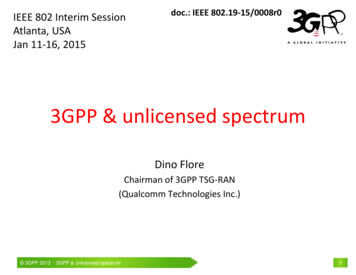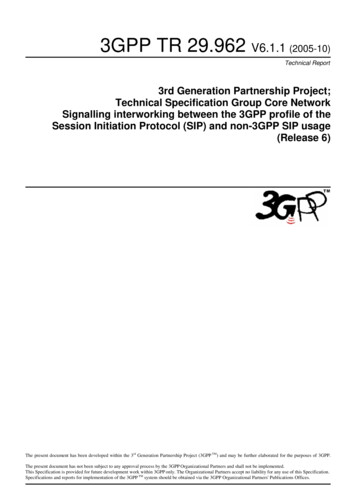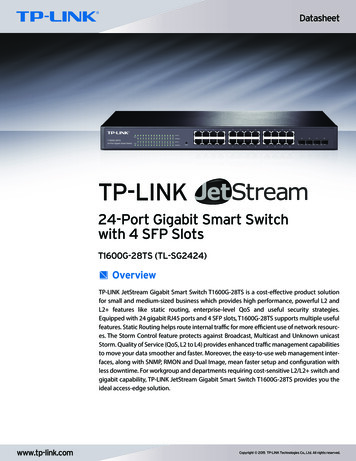
Transcription
IEEE 802 Interim SessionAtlanta, USAJan 11-16, 2015doc.: IEEE 802.19-15/0008r03GPP & unlicensed spectrumDino FloreChairman of 3GPP TSG-RAN(Qualcomm Technologies Inc.) 3GPP 20132009 3GPPMobile&WorldCongress,Barcelona, 19th February 20093GPPunlicensedspectrum1
doc.: IEEE 802.19-15/0008r0OutlineIntroductionLTE/Wi-Fi interworkingLTE over unlicensedCooperation with IEEE 3GPP 20132009 3GPPMobile&WorldCongress,Barcelona, 19th February 20093GPPunlicensedspectrum2
doc.: IEEE 802.19-15/0008r0IntroductionLicensed spectrum remains 3GPP operators’ top priority todeliver advanced services and user experienceOpportunistic use of unlicensed spectrum is becoming animportant complement for operators to meet the growingtraffic demandMoving forward 3GPP operators will have two options tooffload traffic to unlicensed spectrum:1.2.Wi-Fi (via LTE/Wi-Fi interworking)LTE over unlicensedIt will then be up to each individual operator to choose whichapproach to use, which will depend on a number of factors 3GPP 20132009 3GPPMobile&WorldCongress,Barcelona, 19th February 20093GPPunlicensedspectrum3
doc.: IEEE 802.19-15/0008r0LTE/Wi‐Fi interworking 3GPP 20132009 3GPPMobile&WorldCongress,Barcelona, 19th February 20093GPPunlicensedspectrum4
doc.: IEEE 802.19-15/0008r0 Mobility with IP address preservation of all traffic from 3GPP access to Wi-Fiaccess (and policing through ISMP) Mobility with IP address preservation for selected IP flows (IFOM) Simultaneous IP connectivity to 3GPP and Wi-Fi access networks (MAPCON) Improved definition of IP flows for enhanced traffic steering (DIDA)System-levelRel-8Rel-10(Jun. ‘11)(Jun. ‘13)Rel-11(Dec. ‘08)Brief history of LTE/Wi-Fi interworking Transparent IP connectivity via trusted Wi-Fi using GPRS Tunneling Protocol (SaMOG) IP connectivity via Broadband Access, such as DSL line Prioritization of different 3GPP access networks with respect to Wi-Fi (WORM) APN selection based on the type of traffic (IARP) Enhanced Wi-Fi network selection policies (integration with HotSpot 2.0) Offload based on ANDSF and RAN based policies and UE measured quality of3GPP and Wi-Fi radio access 3GPP 20132009 3GPPMobile&WorldCongress,Barcelona, 19th February 20093GPPunlicensedspectrumRadio-level(Mar. ‘15)Rel-12 Multiple IP connectivity via Trusted WLAN using GTP (eSaMOG)5
doc.: IEEE 802.19-15/0008r0LTE/Wi-Fi interworkingFramework being developed since the first release of LTE, Rel-8 With tighter and tighter forms of interworking added in subsequentreleases See previous slide for a brief history of the LTE/Wi-Fi interworkingcapabilities developed by 3GPPNew proposals for even tighter radio-level interworking arecurrently being evaluated for Rel-13, including: LTE/Wi-Fi aggregation Enhanced network controlled mobility, via enhanced UE measurementreporting and network steering capabilities Interface between LTE eNBs and Wi-Fi APs 3GPP 20132009 3GPPMobile&WorldCongress,Barcelona, 19th February 20093GPPunlicensedspectrum6
doc.: IEEE 802.19-15/0008r0LTE over unlicensed 3GPP 20132009 3GPPMobile&WorldCongress,Barcelona, 19th February 20093GPPunlicensedspectrum7
doc.: IEEE 802.19-15/0008r0LTE over unlicensedThe discussion was kicked off by a workshop in Jun. 2014, whichestablished the initial priorities (RWS-140029):5 GHz bandGlobal solution that can work across regionsLicensed-Assisted Access operation Aggregation of a primary cell, operating in licensed spectrum to deliver critical informationand guaranteed Quality of Service, with a secondary cell, operating in unlicensed spectrumto opportunistically boost data rate The secondary cell operating in unlicensed spectrum can be configured either as downlinkonly cell or contain both uplink and downlinkFair coexistence between LTE and Wi-Fi as well as between LTE operators 3GPP 20132009 3GPPMobile&WorldCongress,Barcelona, 19th February 20093GPPunlicensedspectrum8
doc.: IEEE 802.19-15/0008r0Licensed-Assisted Access (LAA)The feature is targeting completion in Rel-13, which is scheduledto freeze in Mar. 2016The Study Item (SI) was approved by RAN in Sep. 2014 and isscheduled to complete in Jun. 2015 Main SI goal: study the LTE enhancements needed to operate inunlicensed spectrum and to ensure fair coexistence with Wi-FiThe detailed SI description is available in RP-141817 3GPP 20132009 3GPPMobile&WorldCongress,Barcelona, 19th February 20093GPPunlicensedspectrum9
doc.: IEEE 802.19-15/0008r0LAA SI: feasibility studyStarted in RAN1 in Q4-14, with initial discussions on: Regulatory requirementsDeployment scenariosDesign targets & functionalitiesCoexistence evaluation & methodologyThe Latest version of the TR is available in R1-145483 Still in draft state (hence not published yet by 3GPP)! 3GPP 20132009 3GPPMobile&WorldCongress,Barcelona, 19th February 20093GPPunlicensedspectrum10
doc.: IEEE 802.19-15/0008r0LAA SI: regulatory aspectsProduced an overview of the regulatory requirementsfor unlicensed operation in 5 GHz See R1-145483, Sec. 4Different regional requirements emerged, in terms ofpower levels, channel sensing etc. 3GPP 20132009 3GPPMobile&WorldCongress,Barcelona, 19th February 20093GPPunlicensedspectrum11
doc.: IEEE 802.19-15/0008r0LAA SI: deployment scenariosScenario 1: Carrier Aggregation (CA) between licensed macro cell (F1) and unlicensed small cell (F3)Scenario 2: CA between licensed small cell (F2) and unlicensed small cell (F3) without macro cell coverageScenario 3: Licensed macro and small cell (F1), with CA between licensed small cell (F1) and unlicensed small cell (F3)Scenario 4: Licensed macro cell (F1), licensed small cell (F2) and unlicensed small cell (F3) CA between licensed small cell (F2) and unlicensed small cell (F3); If there is ideal backhaul between macro and small cell, there can be CA betweenmacro cell (F1), licensed small cell (F2) and unlicensed small cell (F3); If dual connectivity is enabled, there can be dual connectivity between macro celland small cell.Note: Scenario 2 and Scenario 4 will be used in the coexistence study as indoor and outdoor evaluation scenario, respectively. 3GPP 20132009 3GPPMobile&WorldCongress,Barcelona, 19th February 20093GPPunlicensedspectrum12
doc.: IEEE 802.19-15/0008r0LAA SI: design targets & functionalitiesAgreed design targets: Single global solution allowing compliance with any regional regulatory requirementsEffective and fair coexistence with Wi-FiEffective and fair coexistence among LAA networks deployed by different operatorsBased on the above targets, it was agreed that at least the following functionalities arerequired for LAA:1.2.3.4.5.Listen‐before‐talk (Clear channel assessment)Discontinuous transmission on a carrier with limited maximum transmission durationDynamic Frequency Selection for radar avoidance in certain bands/regionsCarrier selectionTransmit Power ControlNote: not all functionalities may have a spec impact; not all functionalities would be mandatory for all LAA eNBs/UEsOn fair coexistence with Wi-Fi Initial qualitative definition provided in the SI description: [ ] LAA should not impact Wi‐Fi services (data, video and voice services) more than an additional Wi‐Finetwork on the same carrier; these metrics could include throughput, latency, jitter etc. [ ]Exact metrics to be defined in the coexistence study 3GPP 20132009 3GPPMobile&WorldCongress,Barcelona, 19th February 20093GPPunlicensedspectrum13
doc.: IEEE 802.19-15/0008r0LAA SI: coexistence evaluationEstablished the initial evaluation scenarios andmethodology More details on the initial assumptions for the evaluationmethodology can be found in R1-145483, Sec 8Initial coexistence results expected to be discussed inH1-15 3GPP 20132009 3GPPMobile&WorldCongress,Barcelona, 19th February 20093GPPunlicensedspectrum14
doc.: IEEE 802.19-15/0008r0Cooperation with IEEE 3GPP 20132009 3GPPMobile&WorldCongress,Barcelona, 19th February 20093GPPunlicensedspectrum15
doc.: IEEE 802.19-15/0008r0Cooperation with IEEEIn general we welcome further cooperation with IEEEThe Chairman of the IEEE 802 coexistence group recently gave RAN an interestingpresentation on the lessons learned when dealing with unlicensed spectrumoperations, RP-141747With this presentation we wanted to give you an early indication of where the LAAwork is going (the work has just started) We will be happy to come back and present the results of the coexistence analysis, once thefeasibility study is completedAny feedback from IEEE 802 is welcome and will be taken into account in the regular3GPP process Lot of interested companies are members of both SDOs and can also contribute directly to3GPPFor instance, if IEEE had a standardized requirement on Wi-Fi to Wi-Fi coexistenceperformance that every Wi-Fi device has to meet, this could complement 3GPPcoexistence evaluations If so, a pointer to the corresponding IEEE specification(s) would be highly appreciatedThis should include the case of uncoordinated networks 3GPP 20132009 3GPPMobile&WorldCongress,Barcelona, 19th February 20093GPPunlicensedspectrum16
doc.: IEEE 802.19-15/0008r0Thanks! 3GPP 20132009 3GPPMobile&WorldCongress,Barcelona, 19th February 20093GPPunlicensedspectrum17
Mobility with IP address preservation of all traffic from 3GPP access to Wi-Fi access (and policing through ISMP) Mobility with IP address preservation for selected IP flows (IFOM) Simultaneous IP connectivity to 3GPP and Wi-Fi access networks (MAPCON) Improved definition of IP flows for enhanced traffic steering (DIDA)










